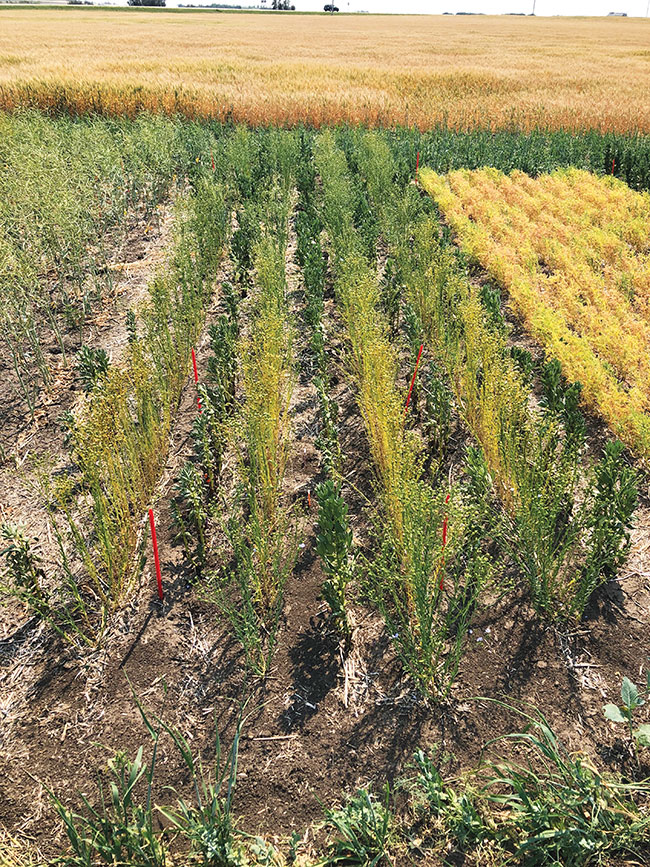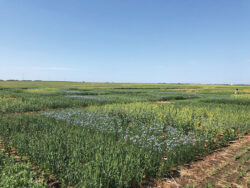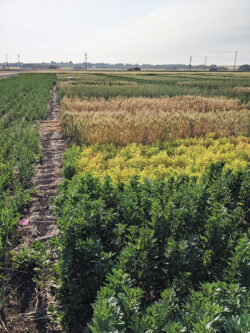
Features
Soil
Soil health indicators and faba bean intercrops
Research shows faba bean intercrops can improve soil health.
July 25, 2023 By Donna Fleury
 The alternate row flax-faba bean intercrop and others performed well in the experiments.
ALL PhotoS courtesy of Warren McAuley, University of Saskatchewan.
The alternate row flax-faba bean intercrop and others performed well in the experiments.
ALL PhotoS courtesy of Warren McAuley, University of Saskatchewan. Intercropping systems are gaining interest as they can provide crop health and yield benefits and lower production costs. Although these intercropping systems can also improve soil health, there is limited information about how intercropping affects soil health indicators. Researchers at the University of Saskatchewan are trying to answer some of those questions.
“In my program, we are taking more of a systems approach to important agronomy questions rather than focusing on individual crops,” explains Maryse Bourgault, assistant professor and WGRF integrated agronomy research chair at the University of Saskatchewan. “We have projects underway looking at intercropping, cover crops and reintroduction of livestock into cropping systems. The priority is to try to determine how growers can increase soil organic matter or soil health in general along with agronomic improvements with these new systems.”
A recent project evaluated faba beans and intercrops and other common intercrops in the Prairies. “We were interested in learning more about various intercrops and, in particular, different companion crops best suited for intercropping with faba beans,” says Bourgault. “One of the questions was whether or not alternate row intercrops with faba beans might improve yields and soil health, and help address foliar diseases for faba beans. Master’s student Warren McAuley led a two-year project focused on soil health indicators and the improvements that could be shown in a year or two. Crop disease was not the focus and with dry conditions, particularly in 2021, we didn’t really see much impact from disease in any of the experiments.”
The objectives of the project were to determine whether or not faba bean intercrops provided yield advantages and to assess soil health factors and changes between monocrops and intercrops. The experiments were conducted over two years at the Kernen Crop Research Farm near Saskatoon. Faba bean intercrops included faba bean-flax, faba bean-canola, faba bean-oat and faba bean-wheat. Other intercrops included pea-canola, chickpea-flax and lentil-wheat. Every crop was also grown as a monocrop for comparison. The intercrops were seeded as alternate rows using the standard seeding rate for each crop. Only the non-legume monocrops received nitrogen fertilizer at a rate of 67 kg/ha of urea, and a starter rate of phosphorus fertilizer was applied to all experiments.
“The soil health metrics selected were based on the recent Saskatchewan Soil Health Assessment that highlighted five main factors indicative of a healthy soil in Saskatchewan,” explains McAuley. “These include total nitrogen, soil protein, organic carbon, active carbon and total phosphorus. Soluble N was also measured in the study. Soil samples were collected three times during the growing season, including before seeding, at flowering and after harvest. Crop grain yields were measured for all experiments.

Research project evaluating faba bean intercrops and other common intercrops in the Prairies.
“Our study results indicated an increase in two of the short-term soil factors, including active carbon and soil protein, both showing a greater increase in values in the second half of the year in legumes. The legume monocrops were always greater than the non-legume monocrops for these two soil health factors, and the intercrops were in between. As an indicator of soil health, the soil protein and active carbon increase is more indicative of improved soil microbial populations. Active carbon is readily digestible by microbial populations and the increase in soil proteins result from either plants or microbes exuding protein into the soil or from microbes dying. It was really positive to see the improved soil health from legumes that are providing a healthy environment for soil life. Their strong connection with soil microbes and partnership with rhizobia for nodulation and improved yield makes them a good intercrop companion and cropping option.”
In terms of intercrops, some of the faba bean combinations performed quite well with good yields, however others were not so successful.
“Yield differences were compared using the land equivalent ratio (LER) concept. The faba bean-flax intercrop showed promise, with a LER of 1.09 or yields of nine per cent higher than the monocrops,” notes McAuley. “As expected, the pea-canola intercrop performed very well with an LER of 1.25 or 25 per cent greater than either crop as a monocrop. Unfortunately, both the faba bean-oat and faba bean-wheat were mostly failures. In these intercrops, the cereals seemed to take the moisture away from the faba beans, which were short and dried down mid-season, resulting in little to no faba-bean yield. Overall, some of the faba bean intercrops and other common intercrops performed very well both for yield and improved soil health indicators. Intercropping has a history of success and may have a fit in some areas and for farmers that are interested in trying it.”

The experiments compared various intercrops, plus all individual crops were included as a monocrop for comparison.
“The results support what we already know about the benefits of faba bean and legumes in general for soil health, which we see in the soil carbon and soil protein data in this study,” adds Bourgault. “The pea-canola intercrop was also more productive when grown together than as monocrops. For me, it was interesting to note that the intercrops did not receive any nitrogen fertilizer. Therefore, the canola did quite well with residual N from 2021 as an intercrop, which could result in significant savings of urea in intercropping systems with non-legume crops.”
Going forward, it would be good to take a closer look at how much N gets transferred between the legume and the oilseed crops. Bourgault notes that colleagues in Australia are just completing a multi-site intercropping study that shows legumes and oilseeds seem to work well and better than cereal intercrops.
“Our study showed quite dramatic differences in faba bean intercrops and showed what good (and bad) intercrop companions could be for faba bean. Certainly, the faba bean-flax performed very well, but not the cereal intercrops, something we need to explore more. This area of cropping systems and soil health is where we could use more science for semi-arid locations like the Prairies in the future.”